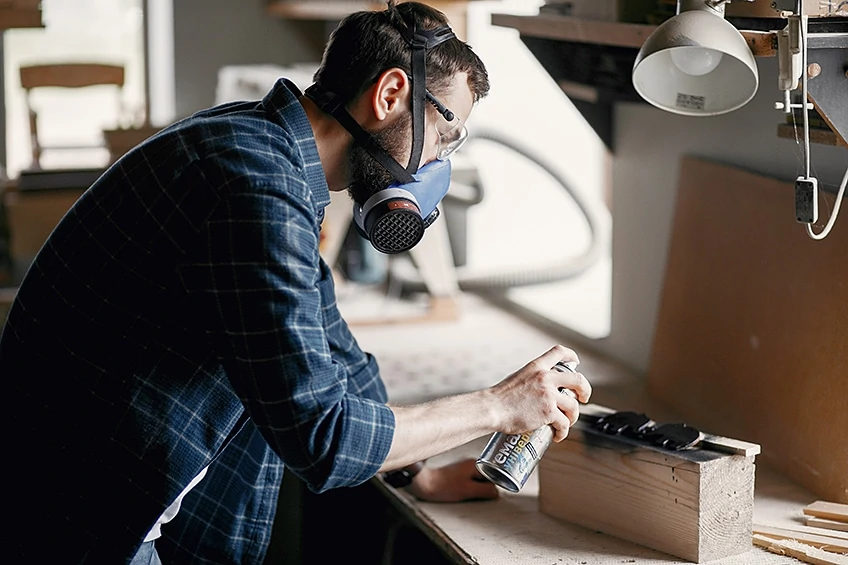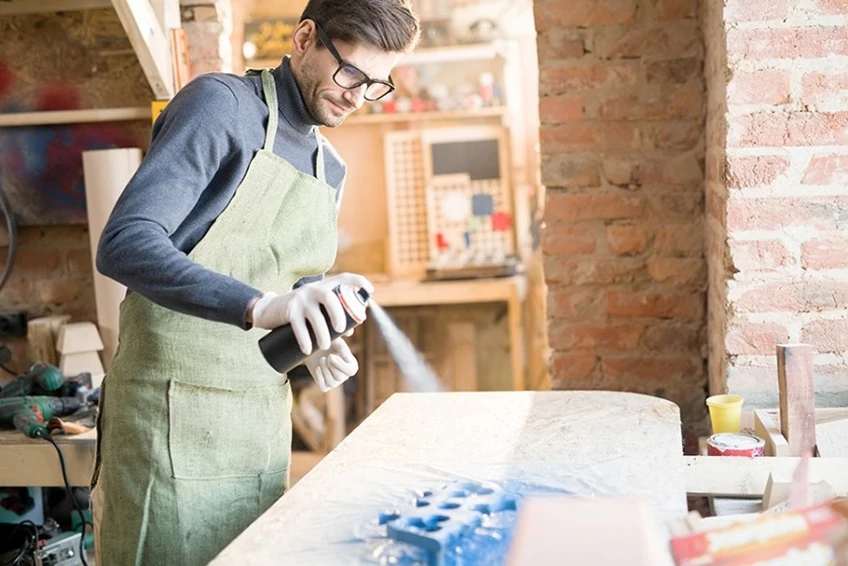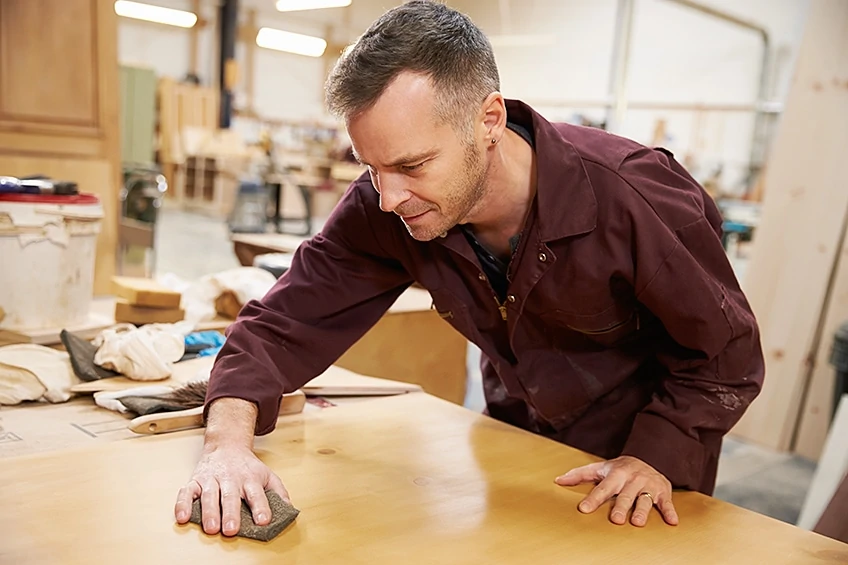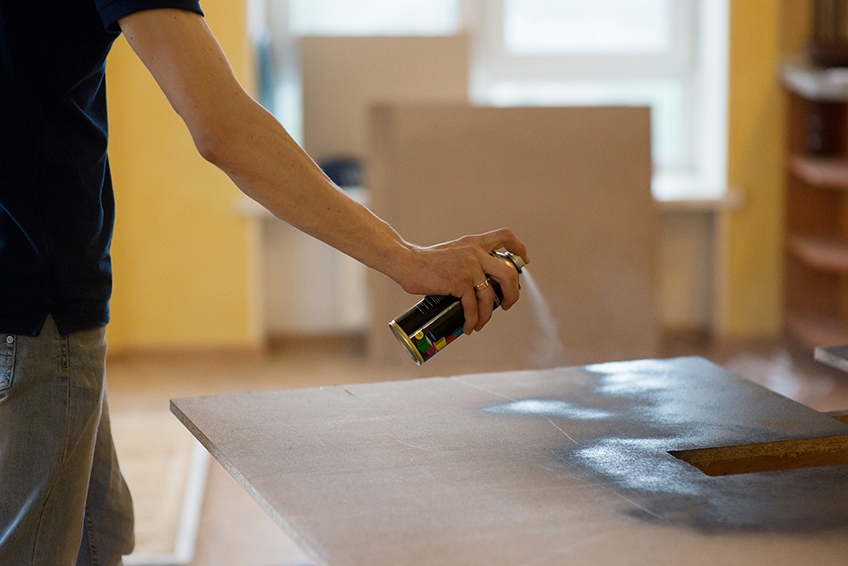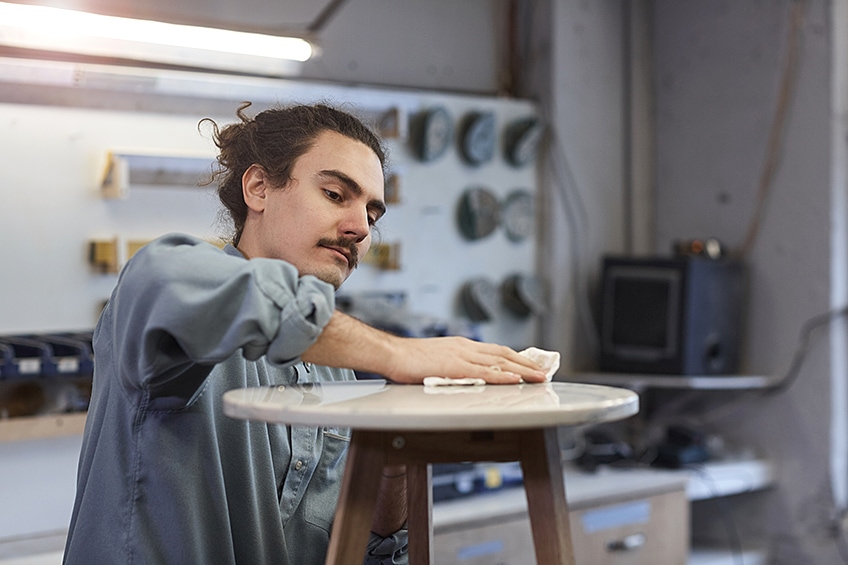Best Polyurethane Spray – Tutorial and Buying Guide
This post may contain affiliate links. We may earn a small commission from purchases made through them, at no additional cost to you. You help to support resin-expert.com
Polyurethane is an effective and helpful product; it is durable, clear, and gives you a perfect surface finish. However, if you, as a DIY enthusiast, are using it for the first time with little experience, you need to take special care. In this article, we will be showing you what to consider when you buy or use polyurethane spray paint.
Table of Contents
- Should you Spray Polyurethane?
- How to use Polyurethane Spray?
- Best Spray Can Polyurethane
- Best Spray Water Based Polyurethane
- Best Polyurethane Paint Sprayer
- Step-By-Step Guide for Spraying your Items
- Preparation needed for Spraying with Polyurethane
- How to Choose the Correct Polyurethane Paint
- Using Water-Based Polyurethane for Spraying
- Questions and Answers
Should you Spray Polyurethane?
Many apply Polyurethane using a paintbrush, making it difficult to get that fine finish. By stirring the paint and then wiping the edge with a paintbrush, will automatically create bubbles that will spoil your delicate surface finish. If you are going to use a brush on your project surface, you need to apply the polyurethane with perfect precision so as not to create grooves and bumps.
If you apply the polyurethane incorrectly, or if the humidity is high, it can cause moisture to be trapped under the surface which will give you a white or cloudy finish. Problems that could occur can be many. The ideal method is to apply spraying polyurethane using a paint sprayer, which automatically removes human error and makes the whole process less reliant on the skills of the painter.
Spraying Polyurethane relies on a couple of additional steps, that if followed, will guarantee a quality job, and provide you with a great finish. Doing it correctly will also save you a lot of time, not having to fix your mistakes.
How to use Polyurethane Spray?
Spraying polyurethane is so much easier and more effective than using a brush, and the technique involved is easy to grasp. When you start spraying make sure your sprayer always remains between 10 and 12 inches from your project surface. This will ensure that your paint layer or coat stays smooth and level without any bumps and globs.
Once you start to spray, you need to continue in one long flowing movement. If you stop halfway and then continue it will result in an uneven finish, which will be difficult to repair later. This process needs to be followed with every layer or coat of paint. Spray until you reach the end, and only then do you stop.
Another useful tip is to start spraying slightly before you reach your surface and then continue to spray right across the entire surface, and then go beyond that before you stop. Keep your hand secure and your wrist firm during the entire process. If you bend or move your wrist at any time, it will result in an uneven coat and will not produce a straight line.
One of the key issues in knowing how to use spraying polyurethane is to understand what settings you need to use. If you are an experienced sprayer you will know what settings and setups to use and you can then quickly adjust as you go along.
To help you understand this, make use of the vertical setting, that is spraying up and down if you are going to spray columns or items like table legs. Then use the horizontal setting when you are spraying across a flat surface. There is also a middle setting, which can also be referred to as vertical/horizontal or circular setting. This setting is perfect when spraying edges, curves, or corners.
Best Spray Can Polyurethane
MINWAX Polyurethane
Using this Spray Can Polyurethane helps to protect your wooden furniture and interior items without difficulty, as it comes in an aerosol can. This is a highly versatile product, as it gives the best protection and durability to your wooden items and at the same time is supplied in a convenient aerosol can. By using this spray can polyurethane, it will enhance the value of your wooden furniture and can also be applied to unfinished or finished surfaces.
- Provides long-lasting beauty and protection to any interior wood surface
- Among the most durable coatings for wood protection
- Ideal for woodworking, furniture, doors, cabinets and floors
This Polyurethane Spray Can Paint dries extremely fast after it has been applied and provides long-lasting beauty to a variety of different types of wood. It gives a long-lasting surface finish to your wood and brings out the natural beauty of your wooden objects. The aerosol can make it easy to apply and helps you to take care of your wooden furniture, as it will protect them from various forms of damage.
Best Spray Water Based Polyurethane
RUST-OLEUM Varathane Ultimate Polyurethane
This Water Based Polyurethane Spray is highly versatile, as it provides a clear surface finish and is also suitable for various types of projects such as trims, doors, interior furniture, and cabinets. This Spraying Water Based Polyurethane is the best product on the market for scratch-resistant protection on your furniture, which makes it excellent for those of you who have small children and pets.
- Protects outdoor wood surfaces such as furniture, fences, boats, trim and more
- Weather and UV resistant, Water based formula dries fast
- Dries to the touch in 30 minutes with coverage up to 12 sq. ft. per can, recoat after 1 hour
The Water Based Polyurethane Spray is extremely easy to apply, due to its water-based formulation. Also, the spraying water based polyurethane leaves you with a clear satin surface finish. This type of finish will improve the look of your wooden furniture and is guaranteed not to yellow, even over a long time. Since it is water-based there is a very low odor, which makes it perfect for use indoors and on numerous wooden surfaces.
Best Polyurethane Paint Sprayer
GRACO Ultra Max Cordless Airless Handheld Paint Sprayer
This handheld sprayer is a great product for spraying polyurethane. The sprayer is easy to use and will save you a lot of hassle, it is also cordless. It is powered by a DEWALT XR Lithium Battery System, which can charge about 30% faster than any other cordless model. A single charge will allow you to spray nearly one gallon of paint.
- Perfect Airless Finish at Any Speed - Without Thinning
- Fully Repairable for Extended Life, Uses RAC X FFLP Spray Tips
- Sprays Water, Solvent, and Flammable Based Materials
This airless handheld sprayer will give you a perfect finish on almost any base material. It enables you to work much faster, which means it will save time, and improve your productivity. You will soon have an excellent smooth durable finish in a flash. All of this will be made possible when you use this fantastic cordless airless paint sprayer.
Since this handheld paint sprayer is cordless, it will provide you with the opportunity to take it with you wherever you go. Because you don’t have to worry about the electric cord or access to an electric socket, you can use this sprayer indoors, outdoors, or on any of those awkward and difficult to get to places.
Step-By-Step Guide for Spraying your Items
Preparation
Preparing the surface of your project is just as important as applying the paint. You need to start by first sanding down the surface of your item. Then if there are any gaps or holes you must fix these first. Next, you can put on the stain, make certain everything is completely dry before you begin.
Once the stain has dried, you can start applying your polyurethane but ensure that you are working in a dust-free space. You also need to make sure that there is no dust or any foreign objects on the surface of your project before you spray, as this will affect the finished look.
Clean the entire surface area of your item to ensure all dust has been removed by using a vacuum cleaner or a clean cheesecloth dipped in denatured alcohol (for use with water-based polyurethane) or a clean cloth dipped in mineral spirits (for use with oil-based polyurethane). This is to ensure that the paint will adhere perfectly to the surface. Remember, a clean surface area is essential.
Choose the Right Tool for Spraying
For spraying with polyurethane, you will need to use a tip that can spray between 1 to 5 inches wide. Most of the airless sprayers provide you with several different tips to use, however, if you have a different sprayer extra tips can be purchased at most hardware stores or also online.
Now you will have to adjust your volume control knob. This may prove to be a bit tricky, as you want to have your sprayer spraying just enough polyurethane so that you have a coating that is even each time you pass over the surface area.
The Best Technique for Spraying
The right technique is to make one long and continuous movement because if you stop and start during your spraying, you will finish up with a very uneven surface finish. By leaving more polyurethane in one area than in another could result in your paint dripping or running.
You need to strive for an even and smooth finish that is equal in thickness over the entire surface area. One sure way to make certain you apply an even coating is for you to maintain a rigid wrist. If you let your wrist bend when you start or finish a stroke it will create an arc.
This means that you will be applying more polyurethane in the middle of your item and less at the end and the beginning. If you keep a rigid wrist when spraying, this will give you an even coating that will remain the same thickness over the entire surface area of your item.
Spray Patterns
In this article, we will be referring to the 3 main spray patterns.
Horizontal Pattern: This spray pattern is used for spraying vertical surfaces like doors, cabinet sides, and fronts. This means that the spray pattern sprays from right to left or left to right and you can use this technique for vertical surfaces.
Vertical Pattern: This spray pattern is used for spraying horizontal surfaces like tabletops. This means the pattern sprays from the top and down and from bottom upwards.
Circular Pattern: This spray pattern is used for spraying tabletops, doors, or dresser fronts. This means the spray pattern sprays in a circular movement and can be used on vertical and horizontal surfaces.
Cleaning and Drying
When you have finished spraying your item let it dry properly, which could take some time. Remember, if you have painted with oil-based polyurethane, it will take a lot longer to dry thoroughly. Once you are satisfied the surface is completely dry you can use some water to clean it.
Preparation needed for Spraying with Polyurethane
Polyurethane paint has a high viscosity and, therefore, you may need to make use of a thinner to reduce the thickness to be able to spray it properly. If you are not sure if you should add thinner or not, just spray a sample without the thinner and observe the result.
If you have sprayed your sample material without the use of a thinner and you observe orange peel or huge clots on the surface, you will know that you need to add thinner or you can also increase your air pressure slightly. If you are using suction or gravity feed spray guns and find that paint will not flow through the nozzle, then you will have to add a thinner to reduce the viscosity slightly.
You now know that you must add thinner if this is the case, we suggest that you refer to the coatings technical datasheet. This will guide you into which thinner you must use or even refer you to an appropriate cleaner that can be effectively used as a thinner.
The use of thinners for polyurethane can vary based on several factors, but normally you will require 10% more thinner. This is to thin the paint enough to be able to spray it. The most important guide is to read your coatings technical data sheet, which will inform you as to how the paint is to be sprayed.
How to Choose the Correct Polyurethane Paint
What is Best to use Water-based Polyurethane or Oil-based?
It is not just a matter of going ahead and applying the polyurethane coating on your surface. You first need to know how to spray the paint and know if you should use water-based or oil-based polyurethane.
Both of these types of polyurethane have their specific uses. They are both exceptionally durable and make your surface look great, but they do have some different qualities. So, to start, you must choose the correct type of paint that suits your particular project.
The Time it Takes to Dry
The most obvious contrast between the two types is how long it takes for each to dry. Water-based polyurethane dries much quicker than the oil-based variety. So, depending on what you want the paint for, you should choose the correct one to suit your needs.
The water-based polyurethane will take around 2 hours to dry and once it has dried there is no more odor and you can easily clean your tools with water. However, the oil-based polyurethane takes around 12 hours to dry and it has a heavy odor, so you cannot stay in the room while it is drying, also you need mineral spirits to clean your tools.
Finished Appearance
Another important difference for you to consider is the final look. The oil-based polyurethane will give you an amber hue to your finished surface, whereas the water-based polyurethane will not give you that brilliant surface finish. However, it will provide a clear finish if this is what you are looking for.
The water-based polyurethane requires several layers to give you the right finish, whereas the oil-based polyurethane needs fewer coats to obtain the same finish. So, after all, is said and done, oil-based polyurethane is a better choice than water-based polyurethane for some projects.
Using Water-Based Polyurethane for Spraying
If you have decided to switch from using oil-based to water-based polyurethane, then there are some benefits involved.
These benefits include:
- Less odor
- Environment friendly
- Not as much of a fire hazard
These benefits will truly make your switch worthwhile. However, you need to understand that there is a lot more work involved when applying the spray water-based polyurethane.
Indeed, the process of filling the gun with paint and the movement of spraying the surface is the same despite what type of polyurethane you are using. However, there are a few significant differences that could cause problems and discourage your switch from oil to water-based polyurethane.
Let us take a look at some of these problems:
- Spraying: Any water-based polyurethane is not easy to spray, especially if your surface finish is cold. So, we suggest you use an air-assisted airless or an airless sprayer. The air-assisted airless sprayer is by far the best choice. If you want, you can also thin the water-based polyurethane with some water, which will help you to spray the paint better.
- Drying: When compared to other water-based brands, the water-based polyurethane takes more time to dry. To make matters worse you can’t add any spirits or solvents to speed up the drying time. The best method to use if you want to speed up the drying process is to heat the surface or increase the airflow.
- Take care: Before you start to spray your item, take care not to stain the surface area
- Cleaning: One of the main problems you encounter when switching to a water-based coating is the cleaning of the spray gun and accompanying equipment. We suggest these methods; dismantle the spraying equipment and then clean each part by scrubbing them using a brush. Also, you could use a gun-cleaning solvent that is sold by the manufactures for that type of paint.
- Preparation: Once you have applied the first layer, you need to take extra care by sanding it down before you can apply the second coat. Once the first layer is smooth, the rest of the spraying will go easy.
Once you have finished spraying your water-based polyurethane coating it will require some extra work. Once thoroughly dry, it needs to have a final coat to give you that quality finish. This extra step can be avoided if you use oil-based polyurethane, which gives you that brilliant finish after the first coat. This means fewer coats are needed if you use a polyurethane that is oil-based.
Questions and Answers
Do you Need to Thin the Polyurethane before you Spray?
Since polyurethane is a thicker paint it may need to be thinned before you spray. We suggest that you first spray the polyurethane without thinning it and examine the finish, and then decide if you need to thin it or not.
How do I Apply the Polyurethane Coating?
There are three methods you can use, brush-on, spray, and wipe on.
- Brush it: If you are applying the polyurethane to a flat surface then brushing it on is better, as you need to build up a robust coating. With a brush, you can also cover a wider area with each application
- Spray it: It is much easier to spray it on when you are dealing with shutter louvers or any other hard to get at surfaces. When you spray you need to take care to avoid dripping. You will also need some extra time for preparation work to protect areas you do not want to paint. Also, remember that when you spray, you are left with a thinner film that is not as durable as the brush on option. Spray-on polyurethane is also available in aerosol cans
- Wipe it on: This method is best used when doing contoured surfaces like stair balusters or crown moldings were brushing it on might cause dripping. The wipe-on method also leaves you with a thinner film, so you need to make use of this method where there will be less wear
When Spraying Polyurethane, can an Airless Sprayer be used?
Most of the various types of sprayers can be used to spray polyurethane finishes, but they need to be thoroughly cleaned after each use. The airless sprayer produces the best quality spray than any of the other sprayers.
Do you get Polyurethane Spray Paint?
Yes, the Rust-Oleum Specially Polyurethane Spray Paint gives you an excellent protective and clear finish from abrasion, chemicals, scuff marks, and water. This paint can be applied to metal or wood and will outlast a varnish finish by far.
What can Polyurethane Paint be Thinned with?
Polyurethane can be thinned successfully using turpentine, mineral spirits, or paint thinner. If you are using water-based polyurethane you can use water to thin it.
Can Minwax Polyurethane be Sprayed?
Yes, you can spray with it, but why use this brand if there are better and easier options available. All you need to do is go into the store or make a phone call to find the best product. There are also waterborne polyurethane finishes available that are specially designed for spraying.


